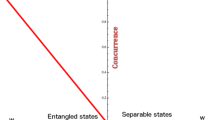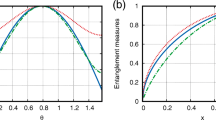Abstract
We present a class of maximally entangled states generated by a high-dimensional generalisation of the cnot gate. The advantage of our constructive approach is the simple algebraic structure of both entangling operator and resulting entangled states. In order to show that the method can be applied to any dimension, we introduce new sufficient conditions for global and maximal entanglement with respect to Meyer and Wallach’s measure.



Similar content being viewed by others
Notes
More generally, the Schmidt decomposition is well defined for pure states belonging to general Hilbert spaces X.
References
Ben-Aryeh Y.: The use of Braid operators for implementing entangled large \(n\)-qubits Bell states (\(n> 2\)). arXiv preprint arXiv:1403.2524, (2014)
Bennett, C.H., Brassard, G., Crépeau, C., Jozsa, R., Peres, A., Wootters, W.K.: Teleporting an unknown quantum state via dual classical and Einstein-Podolsky-Rosen channels. Phys. Rev. Lett. 70(13), 1895–1899 (1993)
Bennett, C.H., DiVincenzo, D.P., Smolin, J.A., Wootters, W.K.: Mixed-state entanglement and quantum error correction. Phys. Rev. A 54(5), 3824 (1996)
Bennett, C.H., Popescu, S., Rohrlich, D., Smolin, J.A., Thapliyal, A.V.: Exact and asymptotic measures of multipartite pure-state entanglement. Phys. Rev. A 63(1), 012307 (2000)
Borras, A., Plastino, A.R., Batle, J., Zander, C., Casas, M., Plastino, A.: Multiqubit systems: highly entangled states and entanglement distribution. J. Phys. A: Math. Theor. 40(44), 13407 (2007)
Brennen, G.K.: An observable measure of entanglement for pure states of multi-qubit systems. Quantum Inf. Comput. 3(6), 619–626 (2003)
Brown, I.D.K., Stepney, S., Sudbery, A., Braunstein, S.L.: Searching for highly entangled multi-qubit states. J. Phys. A: Math. Gen. 38(5), 1119–1131 (2005). cited By 91
Eisert, J., Briegel, H.J.: Schmidt measure as a tool for quantifying multiparticle entanglement. Phys. Rev. A 64(2), 022306 (2001)
Ekert, A., Jozsa, R.: Quantum algorithms: entanglement-enhanced information processing. Philos. Trans. R. Soc. Lond Ser. A: Math. Phys. Eng. Sci. 356(1473), 1769–1781 (1998)
Gisin, N., Bechmann-Pasquinucci, H.: Bell inequality, Bell states and maximally entangled states for \(n\) qubits. Phys. Lett. Sect. A: Gen. At. Solid State Phys. 246(1–2), 1–6 (1998). cited By 149
Graybill, F.A.: Matrices with Applications in Statistics. Wadsworth Statistics/Probability Series, 2nd edn., pp. xii+461. Wadsworth Advanced Books and Software, Belmont, CA (1983)
Grondalski, J.P., Etlinger, D.M., James, D.F.V.: The fully entangled fraction as an inclusive measure of entanglement applications. Phys. Lett. A 300(6), 573–580 (2002)
Heydari, H.: Topological quantum gate entanglers for a multi-qubit state. J. Phys. A: Math. Theor. 40(32), 9877 (2007)
Higuchi, A., Sudbery, A.: How entangled can two couples get? Phys. Lett. Sect. A: Gen. At. Solid State Phys. 273(4), 213–217 (2000). (cited By 68)
Jennewein, T., Simon, C., Weihs, G., Weinfurter, H., Zeilinger, A.: Quantum cryptography with entangled photons. Phys. Rev. Lett. 84(20), 4729 (2000)
Meyer, D.A., Wallach, N.R.: Global entanglement in multiparticle systems. J. Math. Phys. 43(9), 4273–4278 (2002). Quantum information theory
Osterloh, A., Siewert, J.: Constructing \(n\)-qubit entanglement monotones from antilinear operators. Phys. Rev. A 72, 012337 (2005)
Pathak, A.: Elements of Quantum Computation and Quantum Communication. Taylor & Francis, Boca Raton, FL (2013)
Rieffel, E.G., Polak, W.H.: Quantum Computing: A Gentle Introduction. MIT Press, Cambridge, MA (2011)
Tapiador, J.E., Hernandez-Castro, J.C., Clark, J.A., Stepney, S.: Highly entangled multi-qubit states with simple algebraic structure. J. Phys. A: Math. Theor. 42(41), 415301 (2009)
Uhlmann, A.: Fidelity and concurrence of conjugated states. Phys. Rev. A 62, 032307 (2000)
Vidal, G.: Entanglement monotones. J. Mod. Opt. 47(2–3), 355–376 (2000)
Yang, C.P., Chu, S.I., Han, S.: Efficient many-party controlled teleportation of multiqubit quantum information via entanglement. Phys. Rev. A 70(2), 022329 (2004)
Author information
Authors and Affiliations
Corresponding author
Additional information
Partially supported by PRIN2011 Project “Metodi Logici per il trattamento dell’informazione”.
Rights and permissions
About this article
Cite this article
Lai, A.C., Pedicini, M. & Rognone, S. Quantum entanglement and the Bell matrix. Quantum Inf Process 15, 2923–2936 (2016). https://doi.org/10.1007/s11128-016-1302-3
Received:
Accepted:
Published:
Issue Date:
DOI: https://doi.org/10.1007/s11128-016-1302-3




